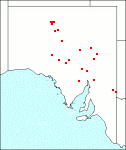Family: Asteraceae
Leptorhynchos baileyi
Citation:
F. Muell., Fragm. Phyt. Aust. 10:101 (1877).
Synonymy: L. tetrachaetus (Schldl.) J. Black var. penicillatus J. Black, Trans. R. Soc. S. Aust. 45:19 (1921); Helichrysum basedowii J. Black, Trans. R. Soc. S. Aust. 52:230 (1928).
Common name: None
Description:
Slender annual herb 4-25 cm tall; stems ascending to erect, sparingly to much-branched, with a sparse vestiture of cobwebby hairs; leaves linear, with recurved margins, acute apex and a broadly sessile base, mostly 1-2 cm long, 1-1.5 rarely 2.5 mm wide, sparsely pubescent like the stems, more densely so on the underside and with minute glandular hairs on both sides.
Peduncles 2-5 cm long, terminating leafy branchlets up to 10 cm long; capitula broadly campanulate, 7-9 mm long; involucral bracts scarcely extending down the peduncle, with a cobwebby vestiture especially towards the base, margins long-ciliate, the cilia equal to or slightly exceeding the width of the bracts, the majority of the bracts semi-transparently hyaline with a translucent midrib, stramineous, the outer ones narrowly ovate to lanceolate, long-acuminate, the inner ones with linear herbaceous glandular-pubescent claws with scarious margins and linear acuminate laminae; florets mid-yellow.
Achenes oblong-elliptic, slightly contracted at the apex, papillose; pappus bristles three-quarters as long as the floret, obscurely barbellate in the lower half, stiffly plumose in the upper half, of bisexual florets 1, rarely 3, of the female ones generally lacking.
|
|
Distribution:
|
In mulga and Acacia shrubland, on sandy and sandy loam soils.
S.Aust.: NW, LE, GT, FR, EP, MU.
|
Conservation status:
native
Flowering time: Aug. — Nov.
|

SA Distribution Map based
on current data relating to
specimens held in the
State Herbarium of South Australia
|
Biology:
Close to L. tetrachaetus which may be distinguished by its achenes with 4 barbellate bristles as long as the floret.
Author:
Not yet available
|

